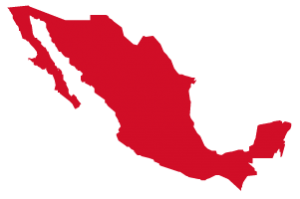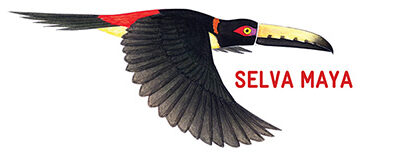 PROTECTED AREAS
PROTECTED AREAS
![]()
BELIZE
Chiquibul National Park
The Chiquibul National Park covers an area of 106,838 ha in Belize and is a natural extention of the Chiquibul-Maya Mountains Biosphere Reserve in Petén, Guatemala. It was originally part of the Chiquibul Forest Reserve. Thanks to pressure from conservationists, the majority of the forest reserve, which had no active logging concessions, was re-designated as a National Park.
The Park is located in the center of the block of protected areas known as the “Maya Mountain Massif” or more simply the “Maya Mountains”, which includes Doyle’s Delight, the highest mountain in Belize. It also contains parts of the Chiquibul cave system, the longest of its kind known in Central America. It has rich biodiversity, including the largest population of scarlet macaws in Belize.
Maya Golden Landscape
The 311,608 hectares of the Maya Golden Landscape are a set of protected areas, private lands and Mayan communities in Belize. The corridor has a great diversity of landscapes, including tropical forests, pine savannas, coral reefs and coastal wetlands.
The Columbia River Forest Reserve, which is part of this set, covers 60,038 ha and is one of the largest tracts of intact forest in Central America. It has several interesting geological features, including large cenotes, caves and rock formations rich in quartz. Its landscape consists of primary and secondary forests, pine savannas and mountain forest.
The Maya Golden Landscape has great ecological importance as the main biological corridor in southern Belize, connecting the Maya Mountains forest area with the Mesoamerican Reef. It contains over 3,000 species of plants, 110 mammal species, 400 bird species and 92 species of reptiles and amphibians, including 18 endemic species and 37 endangered species. Its great diversity of wildlife includes jaguars, crocodiles, manatees and macaws.
Rio Bravo
The Rio Bravo Conservation and Management Area is the largest private reserve in the country and is located in northwestern Belize. It consists of several properties donated or purchased from private companies in the 1980s and 1990s. With an area of 102,790 ha, Rio Bravo is the second largest conservation area of Belize and covers 4% of the national territory.
The landscape is diverse and includes Belizean pine forests, marshes and freshwater lagoons. It has more than 70 mammal species (of which approximately 50% are bats) and 392 bird species. Twenty-two vegetation types and 230 tree species have been catalogued.
The archaeological site La Milpa, located in the northeastern part of the reserve, is one of the largest archaeological sites in Belize.
Vaca Forest Reserve
The Vaca Forest Reserve covers an area of 16,339 hectares. It is located in the Cayo District and borders Guatemala to the west. Vaca is one of the first five protected areas declared in Belize in the 1930’s.
Mountain Pine Ridge
The Mountain Pine Ridge Forest Reserve is located in the Cayo District and was established in 1944 to protect and manage the native pine forests of Belize.
The predominant vegetation in Mountain Pine Ridge is pine (Pinus caribaea mainly), but there is also an important broadleaf forest component. Large mammals such as puma, jaguar, ocelot, coati and tapir are found in the reserve, as well as endemic species including the julienne frog (Lithobates juliani), the amphibian Eleutherodactylus sandersoni and the fish Poecilia teresae.

GUATEMALA
The Mayan Biosphere Reserve
The Mayan Biosphere Reserve (MBR) is the largest protected area in Central America. With an area of 2,112,940 hectares, it occupies about 19% of Guatemala’s national territory. The reserve has a wide variety of landscapes, wetlands and low elevation mountains. It also includes lakes, lagoons, rivers, cenotes and abundant flora and fauna. The following internal zones are used to promote protection and management in the MBR:
- Core Zone (CZ), includes the protected biotopes El Zotz, Dos Lagunas and Río Escondido; the Río Azul-Mirador-, Yaxhá-Nakum-Naranjo-, Laguna del Tigre-, Sierra del Lacandón- and Tikal National Parks. The CZ is restricted to research, conservation, protection and low-impact ecotourism
- Multiple-use Zone (MUZ),intended for the use and exploitation of natural resources in a sustainable manner
- Buffer Zone (BZ), which acts as a buffer to threats to natural resources in the Core Zone. Agriculture, forestry and livestock production are allowed in this area.
The MBR contains dozens of archaeological sites which represent the blossoming of one of the most advanced civilizations in the Americas. Tikal, its most famous site and known for its iconic ‘Temple of the Great Jaguar’, is one of the most important cities of the Classic Maya Period and was the biggest rival of Calakmul. Other important archaeological sites include El Mirador, Nakbe, Uaxactun, Río Azul, Piedras Negras, Yaxhá and San Bartolo.
Mirador-Río Azul National Park
The Mirador-Río Azul National Park is located in northeast Guatemala within the Maya Biosphere Reserve. It covers an area of 116,911 hectares and is divided into two blocks, the west, known as El Mirador and the east, Río Azul, which includes the protected biotope Naachtun – Dos Lagunas. To the north, the park borders the Calakmul Biosphere Reserve in Mexico and to the east, the Rio Bravo Forest Reserve in Belize. Due to its location, the area contains forests typical of the high and humid tropical forests of Petén as well as subtropical forests of the Yucatán.
The National Park is located in the center of the Selva Maya and has remained well conserved mainly because there are no communities within or around its boundaries. This lack of human activity have favored habitat conservation and have been important for maintaining healthy populations of white-lipped peccaries and jaguars.
It also contains major archaeological sites of the Mayan culture, such as El Mirador, Nakbe, Naachtun and Río Azul.
Yaxhá-Nakum-Naranjo National Park
The Yaxha-Nakum-Naranjo National Park, also known as Cultural Triangle Yaxha-Nakum-Naranjo, covers an area of 371,600 ha and is located in the Mayan Biosphere Reserve, Guatemala. It is made up of forests, rivers, lagoons and wetlands, for which it was declared a RAMSAR site.
Three archaeological sites within its borders give the park its name: Yaxhá, Nakum and Naranjo.
Yaxhá was a Mayan city built on the banks of Lake Yaxhá and contains a multitude of temples, palaces and observatories. Some structures are restored, others still covered by jungle vegetation. Nakum is found 18 km north of this area and after Tikal, it has the highest number of restored buildings. Restoration work and research was recently started in Naranjo.
The fauna of the National Park includes Morelet’s crocodile, white fish, the Central American turtle which is endemic to water bodies of the Petén, spider monkeys and collared peccary. It is estimated that 90% of this park’s flora has not yet been registered.
Tikal National Park
Tikal National Park was created in 1955 and covers an area of 57,583 ha. On 1979 it was declared a mixed World Heritage Site by UNESCO for both its immense natural and cultural value. Its most famous cultural landmark is the ancient Mayan city of Tikal, located in the center of the park.
This is the largest restored archaeological site in the Americas. It has approximately 3,000 structures, including palaces, residences, ball courts and temples, of which the most famous are the Temple of the Great Jaguar and the Temple of the Two-Headed Snake which is 70 meters high. Several structures have not been excavated yet.
Large animals such as spider monkeys, howler monkeys, coatis, toucans and ocellated turkeys are found in Tikal. There are also jaguars and pumas, but these are rarely seen.
Trees such as the ceiba, cedar, sapodilla, mahogany and the Ramón tree are abundant, among others. There are also hundreds of species of orchids and bromeliads.
Sierra del Lacandón National Park
The Sierra del Lacandón National Park was created in 1990. It encompasses an area of 202,865 hectares and is part of the Core Zone of the Mayan Biosphere Reserve. The Sierra del Lacandón has great importance for the Mesoamerican Biological Corridor which links protected areas of northern Guatemala with those in southern Mexico, in Chiapas and Tabasco. It also meets important conservation objectives, including its role as a germ plasm bank, connecting wilderness areas in the region and protecting aquifers that provide drinking water to neighboring communities.
Many threatened or endangered species are found in the park, species on the CITES list and the list of endangered species of the National Council of Protected Areas. Examples include jaguar, puma, ocelot, margay, tapir, anteater, howler monkey, spider monkey, scarlet macaw and crocodile.
The Sierra del Lacandón also includes important archaeological sites such as the monumental city of Piedras Negras and at least 29 other Mayan archaeological sites.
Laguna del Tigre National Park
The Laguna del Tigre National Park was created in 1989 and covers an area of 290,000 hectares. It is part of the Core Zone of the Mayan Biosphere Reserve. The park contains singular landscapes such as lakes and wetlands, as well as three distinct vegetation zones with 14 natural ecosystems.
The largest freshwater wetlands in Mesoamerica are found in the Park. It is one of the only places in Guatemala where can still observe scarlet macaws (Ara macao) in its natural habitat.
The Park contains the El Perú archaeological site, a city named for its original inhabitants such as the Waka’. It played a very important role in the ongoing rivalry between the two monumental cities of Tikal and Calakmul and was an ally of the latter until 742 A.D. when it conquered Tikal.
Chiquibul-Montañas Maya Biosphere Reserve
Chiquibul-Maya Mountains Biosphere Reserve has an area of 123,685 hectares. It is located in the southeastern part of the department of Petén. The northern part of the reserve, called Chiquibul, has an elongated shape extending north to south, while the southern part, known as the Maya Mountains, is narrow from east to west. Both areas border Belize.
Due to variations in elevation, the reserve is home to species typical of temperate regions as well as rainforest flora. The biodiversity of this area is highly threatened by human activities, which go beyond the borders of Guatemala and extend to the Maya Mountains in Belize; the area in Belize is in a better state of conservation.
Protected Aareas of the south of Peten
In the south of Petén there are nine Protected Areas, important remnants of forest in the region. They are distributed in the municipalities of: Sayaxché, San Luis, Poptún, Dolores, Melchor de Mencos, San Francisco and La Libertad, with a total area of approximately 411 379 hectares.
San Román Biological Reserve is located within the basins of the Salinas and San Román Rivers and covers an area of 18,646 hectares. It is currently affected by human activity.
Petexbatún Wildlife Refuge extends over 4,044 hectares and includes the Petexbatún Lagoon, the Petexbatún Creek, the Aguateca Creek and the adjacent wetlands to the east of these bodies of water; all of which form an important refuge for a large number of waterfowls, fish, turtles and crocodiles.
Aguateca Cultural Monument is an archaeological park around a portion of high broadleaf humid forest. Within this forest lies the Mayan city of Aguateca of the Late Classic and the secondary site of Dos Ceibas.
Dos Pilas Cultural Monument is an archaeological park that protects 3,120 hectares of broad-leaved, tall and dense forest. Part of its importance lies in the existence of the Dos Pilas archaeological site and a system of 7 caves.
El Rosario National Park is one of the core areas that has been best preserved despite the accelerated deforestation processes in the vicinity. During the rainy season, it forms an important wetland system when the Laguna El Rosario reaches the low forests of the La Pasión river valley.
Ceibal Cultural Monument, which extends over 1,512 hectares, is located on the west bank of the La Pasión River. Ceibal is a biodiverse island in an area heavily influenced by deforestation.
El Pucté Wildlife Refuge has an extension of 16,695 hectares; 31.5% of which are wetlands with low-flooding forest that has remained relatively well preserved. It is an important producer of water thanks to its many springs.
Machaquilá-Xutilhá Wildlife Refuge extends over 102,538 hectares, with unique landscape elements such as natural caves, sinkholes, rivers, archaeological sites and ceremonial caverns.
Maya Mountains Biosphere Reserve has a total area of 123,685 hectares including outstanding natural areas of great beauty, including rivers, caves, coniferous forests and archaeological sites. The Mopán and Chiquibul rivers are nesting areas of the harpy eagle.

MEXICO
Calakmul Biosphere Reserve
The Calakmul Biosphere Reserve is located in the southeastern part of the state of Campeche, in the Calakmul municipality, and covers an area of 723,185 ha. It is the second largest reserve in the country after El Vizcaíno, Baja California and was recognized as a Mixed World Heritage Site (both natural and cultural) by UNESCO in 2014. This is due to the fact that the Calakmul Biosphere Reserve, in conjunction with the Balam Kú and Balam Kin state reserves which border it, represents one of Mexico’s, and the world’s, most valuable biodiverse areas of the tropical forests with a total of more than 1 million hectares. To date, 358 bird species have been registered as well as 75 reptile species, 18 amphibian species, 31 fish species, 380 butterfly species and 86 mammal species. It also has one of the largest populations of jaguar in Central America.
Its rich cultural heritage is represented by more than six thousand archaeological structures in the region, traces of the splendor of the Mayan culture. It’s most important representation is the archaeological site of Calakmul, one of the most conspicuous cities of the Mayan classic period. Structures I and II, pyramids of approximately 45 meters in height, are found here.
web site: http://calakmul.conanp.gob.mx
Balam Kú
The Balam Kú Natural Protected Area abuts the Calakmul Biosphere Reserve, and with an area of 409,200 hectares, it significantly expands the protected territory. Together with the Calakmul Biosphere Reserve and Balam Kin, it forms part of a large biological corridor.
Balam Kú, like the Calakmul Biosphere Reserve, has a mixture of high, medium and low altitude forests with approximately 109 species of trees. It is estimated that there are 383 species of terrestrial vertebrates (12 amphibian species, 64 reptile species, 243 bird species and 64 mammal species) in the reserve; 26% of them are under some kind of protection.
Regarding the cultural heritage, two archaeological sites have been discovered in the reserve, Balam-Kú (“The House of the Jaguar”) and Nadzca’an.
Balam Kin
The Balam Kin state reserve, encompassing an area of 110,990 ha, is located in the state of Campeche and is administered by SEMARNATCAM. Together with the Calakmul Biosphere Reserve, it serves an important role as a biological corridor.
To date, 324 species of terrestrial vertebrates have been registered, of which 16 are amphibians, 63 are reptiles, 197 are birds and 48 are mammals.
In terms of cultural heritage, Balam Kín has two registered archaeological sites, Hochob and El Tabasqueño.
Sian Ka’an Biosphere Reserve
The Sian Ka’an Biosphere Reserve covers an area of 528,147 hectares on the east coast of the Yucatán Peninsula, Mexico. It contains tropical forests, mangrove swamps, marshes and a vast marine area intersected by a barrier reef, the second largest of its kind after the Great Barrier Reef of Australia. Distinctive natural features typical of the area include Petenes, (tree islands in swamps reaching 30 meter heights) and freshwater pools known as cenotes.
Wildlife found in Sian Ka’an includes various medium and large mammals such as the spider monkey, howler monkey, jaguar and Central American tapir. A small and vulnerable population of the Caribbean manatee is found along the coast. More than 300 species of birds have been registered, as well as 40 species of amphibians and reptiles, including the American crocodile, and four species of sea turtles. The reef is composed of about 80 species of coral and together with other aquatic habitats in the reserve, Sian Ka’an is home to more than 400 species of fish.
To date, 20 Mayan archaeological sites from the 15th and 16th Century have been discovered.
One of the greatest pressures the Sian Ka’an Biosphere Reserve faces is from tourism activities that are expanding southward from the cities of Cancún and Playa del Carmen to Tulum.
Bala’an K’aax Protection Area of Flora and Fauna
In the Yucatec Maya language, Bala’an K’aax can be translated as “hidden forest”. The Bala’an K’aax Flora and Fauna Protection Area (APFFBK) encompasses an area of 128,390 hectares and is a continuation of the Calakmul Biosphere Reserve. This increases the diversity of protected forest environments in the center of the Yucatán Peninsula and is an element of high importance for the development of the Sian Ka’an – Calakmul Biological Corridor.
A special feature of this protected area is that it has significant tracts of lowland flooded forests, an endemic ecosystem of the Yucatán Peninsula. It also has a considerable number of species of flora and fauna, of which 164 are cataloged under some type of risk category. Timber and non-timber forest resources area are of great importance for the local economy. Additionally, the great biodiversity and scenic beauty of Bala’an K’aax present significant ecotourism potential.
Montes Azules
The Montes Azules Biosphere Reserve, one of the most protected natural areas in Mexico, is rich in biodiversity and part of the Lacandona Forest and was decreed on January 12, 1978. It has an area of 331 thousand 200 hectares and is located in the municipalities of Ocosingo, Las Margaritas and Maravilla Tenejapa, in the state of Chiapas. It is one of the most extensive areas of humid tropical forest in Mexico and Central America. The predominant ecosystems are medium and high sub-evergreen forests, and pine-oak forest.
The flora and fauna of Montes Azules is abundant. Invertebrates, butterflies and around 112 species of fish as well as amphibians and reptiles are protected in this area. 27% of the country’s mammals live in this reserve, while 341 species of birds fly through its skies. Among the representative species of flora are chicozapote (Manilkara zapota); Mahogany (Swietenia macrophylla); rosewood (Tabebuia rosea) and oak (Quercus peduncularis).
Inside the reserve are find the Lacan Tún River basin and the rivers Lacanjá and Jataté form its natural limits. In the area there are also bodies of water, in the north there is a large complex of several lagoons such as Laguna Ojos Azules, Laguna Ocotal, Laguna Yanqui and Laguna El Suspiro. In the center-west and northwest of the reserve the Lacanjá and Miramar lagoons are located.
